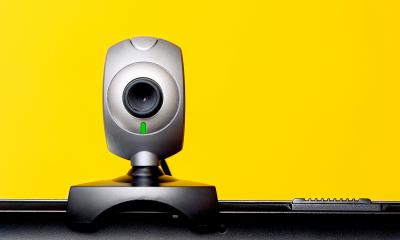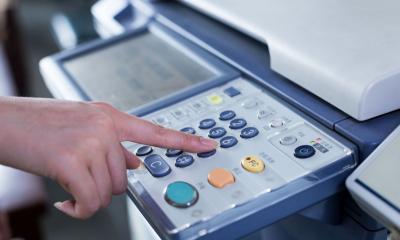
Whatever business you’re in, it’s highly likely you’ll want to invest in some accessories to support you. Printers, scanners, digital cameras and projectors are all useful tools that you might need for your business.
1. Types of printer
Even in the digital age, printers are still an office essential. The days of loading drivers are over, as most printers should work out of the box with Windows devices, Macs and most mobile operating systems including iOS and Android. Many printers now use a Wi-Fi connection instead of a cable, making printing easier for everyone in your office.
Laser printers are best for text, large print volumes and networked use
- Even the cheapest laser printers will produce good quality, crisp printouts.
- Laser printers have low running costs and are the best solution for most businesses.
Inkjet printers can produce vibrant colours and good photographs
- Inkjet printers excel at printing in colour, including photographs.
- High running costs mean they’re not well suited to general business use.
- They are usually cheap to buy initially, but the cost of ink can quickly mount up.
- You may wish to keep an inkjet in your office for occasional photo printing.
Some businesses may require a specialist type of printer
- Dot matrix printers are often used in warehouse and point-of-sale situations. They are old-fashioned, but can tolerate dirty or dusty conditions.
- Plotters can be used to print banners, posters and signs at large sizes. They generally use the same technology as inkjet printers; however they are much more specialised and expensive.
2. Laser printers
Unless you need to print lots of photos, a laser printer will almost certainly be the best option for your business.
Speed is important, so consider how much printing you will be doing
- Small laser printers are suitable for businesses with one to three people using them. They typically print at up to 20 pages per minute (ppm) and are designed to produce 1,000 to 5,000 pages per month.
- Heavy-duty lasers are suitable for larger networks and longer use. Some laser printers are network-ready; others connect to a print server. Large laser printers can print up to 50ppm or in some cases, even more.
Even the cheapest laser printer will produce high quality text
- Print quality is expressed in 'dots per inch' (dpi).
- In general, a higher dpi means a better-quality image. However, figures can sometimes be misleading so it is best to compare sample printouts if you can.
- Text should be printed at a minimum of 600dpi. Most laser printers will offer at least 1,200dpi.
You also need to consider whether you need to print in colour
- Colour laser printers are more expensive than black and white (mono) ones, but are still affordable. Colour printing also costs more per page.
- Most colour laser printers will produce acceptable quality printouts. For text, choose a printer that offers at least a 600dpi resolution. For photos, look for 1,200dpi or more. View test prints to check colour accuracy.
- A colour laser is the most effective way to produce large volumes of colour pages.
- For occasional colour printing, you can supplement a mono laser printer with a colour inkjet printer. This can be at cost-effective solution because it discourages employees from printing in colour unnecessarily.
Paper handling is important if you print in large volumes
- All laser printers can print on A4. You will pay more for a larger, A3 model.
- For a medium-volume printer, look for a printer which can hold at least 500 sheets of paper.
- Some printers have multiple trays, so you can load different paper, then select the tray you want to use.
- You will have to pay extra for a printer that can produce double-sided printouts automatically (called 'duplex'). As double-sided printing can halve your paper costs, it's well worth considering.
- A manual feed makes one-off printing onto labels or envelopes easier.
You will want to connect the printer to your network
- If you only want to print from a single computer, you can connect the printer directly to it using a cable.
- Most laser printers come with a network connection built in. You can connect these directly to your network, so all your computers can share the printer.
- Modern laser printers have an in-built Wi-Fi connection that enables computers, tablets and laptops to wirelessly connect to it.
- You do not need additional hardware to use a network-ready printer, but you may need to install printer driver software onto each networked computer.
- If your printer does not have networking built in, you will need a print server. This is a computer on your network which centralises print jobs.
- It's generally easier for small businesses to buy a network printer, rather than having to set up a print server.
3. Inkjet printers
Inkjet printers are suitable for low volume or occasional printing. They can produce excellent quality photographs.
Inkjets produce good quality text and excellent graphics
- An inkjet printer can produce crisp text, high-quality images and photos.
- Inks are usually water-based and can be smudged.
- Most inkjets print on A4. You will pay more for an A3 model.
- Inkjets generally have a single paper tray, though more expensive models may offer multiple paper options.
Inkjet printers are most suited for use with a single computer
- Print speeds are slower than laser printers.
- Running costs are higher, making inkjets unsuitable for medium- and high-volume work.
Inkjets are cheap to buy, but calculate the running costs carefully
- Many manufacturers sell the printers at a loss, and make the money back on ink cartridges.
- Unbranded cartridges can be cheaper, but the quality is not always as good.
- Look for a model with separate cartridges for each colour. Otherwise, you will have to replace the entire cartridge, even if just one colour runs out.
- You need special coated paper to print photographs at the best quality.
All-in-one devices and 3D printers
An all-in-one devices combine several functions into one piece of hardware
- They typically include a printer, scanner, fax machine and photocopier.
- They save space and usually work out cheaper than buying each device separately. However, you may only be able to use one function at a time.
- If the device breaks, you are likely to lose all functionality while it is being repaired or replaced.
- The cost of all-in-one devices varies depending on their features and capacity.
3D printers allow you to create objects by building up layers of material
- 3D printers usually build objects using layers of plastic or resin.
- Engineers and designers sometimes use 3D printers to create cheap prototypes.
- 3D printers are increasingly used to create products that are sold. They can be used to produce niche items, such as airplane components or prosthetics.
- As the technology improves, applications for 3D printing are likely to broaden and costs for printers get lower.
4. Digital cameras
A digital camera allows you to take photographs and store them on a memory card. You can download them to your computer and share them
- You can copy the photos to a computer and use them online, include them in literature or print them out.
- Digital cameras have many business applications. For instance, they are ideal for taking product shots or staff photographs.
- Digital cameras often take higher-quality images than your smartphone.
The resolution of photographs taken by a digital camera is expressed in megapixels
- The more megapixels (MP), the higher the image resolution. Higher resolution images are clearer, but file sizes will be bigger.
- Most modern digital cameras, including those found on smartphones, are at least 12-18MP, which are perfect for printing on A3 pages and larger. Some digital cameras work at up to 50MP.
- Other factors affecting the quality of an image include the size of the camera's sensor and the quality of the lens.
- Online images are shown at a lower resolution, so the number of megapixels is less important.
Another important item to consider is the camera's zoom
- A good zoom gives you more flexibility when taking photographs.
- Make sure the camera has an optical zoom. A digital zoom simply crops the image and blows it up, reducing it's quality.
- Most compact cameras have at least a 3x zoom. A 16x or 24x zoom allows you to get very close to the action.
- If you're serious about digital photography, choose a camera with a removeable lens. You can purchase specialist lenses for close-up and long-range photography.
When budgeting for a camera, remember that you may require extras
- You will need a memory card to store your photographs on.
- Additional batteries are a great investment, particularly if you work outside or don't have access to the power needed to recharge it.
- A tripod makes low-light photography easier. It can also help you take better photos of products and people.
Smart phone cameras are very capable
- Modern smart phones have excellent cameras built in. They can be as good as - or better than - many mid-range digital cameras.
- Unless you are taking photos to use in brochures or other marketing materials, a smart phone may be all you need.
5. Projectors
Projectors are used to display large images on a screen
- You can connect a projector to your computer and use it for presentations, to show slideshows, films and more.
- Some projectors can also be connected to DVD players and other video sources.
- Wi-Fi projectors can connect to any suitable networked device.
A projector's brightness is measured in ANSI lumens
- The higher the number of ANSI lumins, the brighter the image.
- When shopping, look for at least 1,200 ANSI lumens for a projector that will work well in a dim room, 2,000 for use in a normal office environment, and 3,000 for use in brighter light.
You should also check a projector's resolution
- A projector's resolution is a measurement of the number of pixels it uses to generate an image.
- The native resolution figure is most important. The higher this is, the more detailed the image will be when it's projected.
- If possible, get a Full HD (high definition) projector. This will project images in high definition, giving the greatest clarity.
Make sure your projector has the correct input ports
- You’ll need to ensure your device has the correct port and cable to connect to the projector.
- Most projectors use a DVI or HDMI ports to connect to computers.
- Older projectors may use a VGA connection.
- You can connect any laptop, tablet, and phone to a Wi-Fi projector.
Test a projector before buying
- Check the image quality and brightness in the conditions you will be using the projector.
- Consider the size and weight of the projector. If you need to carry it to meetings, make sure you can manage it and ensure it comes with a carrycase.
Signpost
- Find computer accessory reviews at expertreviews.


